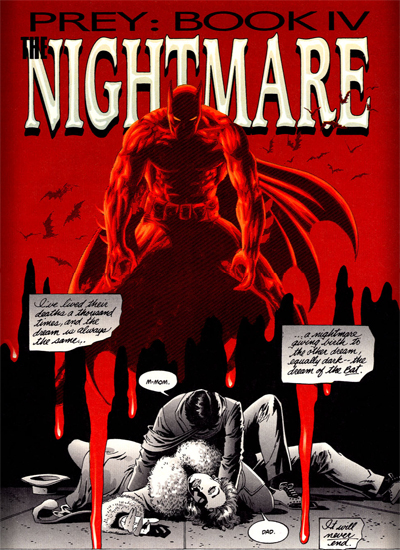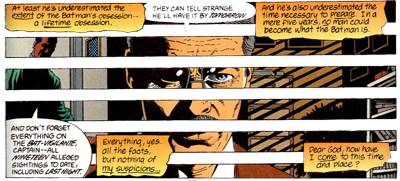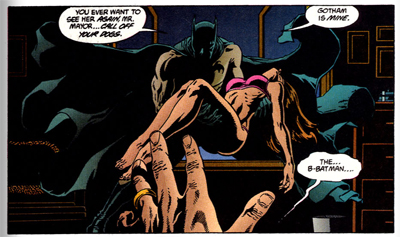To celebrate the release of The Dark Knight Rises, July is “Batman month” here at the m0vie blog. Check back daily for comics, movies and television reviews and discussion of the Caped Crusader.
I actually have a bit of a soft spot for Doug Moench’s Batman work. That is, of course, before he and Kelley Jones got shunted off to work on whatever insane Elseworlds concept they could concoct, like Batman: Haunted Gotham or Dark Joker the Wild. (Although I think Batman: Vampire wasn’t half bad.) I would really like a nice collection of the work that Jones and Moench did during the nineties – similar to the collections we’ve been seeing for artists like Jim Aparo or Marshall Rogers. I think the pair did a good enough job that they deserve one. (Although I’d rather Breyfogle and Grant first, please.) Still, I think there’s an argument to be made that Prey is perhaps the best of Moench’s Batman work, a story arc the writer did for Legends of the Dark Knight set in the early days of Batman’s career. It’s fascinating, because it’s a wonderful criticism of Frank Miller’s style of Batman writing, long before that school of thought became popular.
I’m going to be honest. I actually quite like the more “moderate” Frank Miller approach to Batman’s psychology. (I say that as if “moderate” is ever appropriate to use in describing something Frank Miller wrote.) I like his work on Bruce Wayne in Year One and The Dark Knight Returns, as he dares to suggest that a man dressing as a giant bat might not be the soundest mental specimen around. That said, I think Miller pushed it too far with The Dark Knight Strikes Again and All-Star Batman and Robin The Boy Wonder, but there’s an argument to be made that those are self-parody. Possibly.
Anyway, I say that because I feel I should be upfront in discussing Moench’s fairly interesting criticism of Miller’s work. I actually think Moench has some great points, and was arguably way ahead of the curve. While Miller’s take on Batman is clever and intriguing, it did become a bit of a problem in the hands of less skilled writers. In an effort to make the character “darker and edgier” and “more realistic”, the character became increasingly paranoid and anti-social and a bit of a jerk-ass. You know you might have a problem with characterisation when two major comic book events are written about how jerk-ish the character has become. (Batman’s isolation was a plot point in Identity Crisis, and his contempt for other heroes treated as a personality flaw in Infinite Crisis.)
Moench was, to be fair, well ahead of the curve in this regard. While Moench was writing Prey, this darker and edgier Batman was becoming increasingly popular. The idea was that this level of pseudo-pop-psychology applied to the Caped Crusader makes him a more rounded character. It’s telling then, that Moench reimagines Hugo Strange – one of Batman’s earliest foes – as a pop psychologist who take great pleasure in psychoanalysing Batman, to often hilarious and ridiculous results.
It’s hard not to take this interpretation of Strange as a bit of a pot-shot at the armchair intellectuals so keen to paint Batman as little more than a psychopath in a silly costume. Moench goes out of his way to present Strange as this ridiculously pathetic figure, with his sex doll and his cheap Batman outfit. Hugo Strange has an almost sexual fixation on Batman, linking the vigilante’s violence to his “primal urges”– have we gone too far in delving into the psychology of a fictional character?
Moench repeatedly suggests that a little mystery is necessary for Batman, and that deconstructing and analysing him might kill the joy of the character. When Batman fights a naked hairy sweaty man, he insists, “He needs his pants.” Does Batman also need to remain fully clothed, rather than stripped and analysed? “It doesn’t work in the daylight,” Bruce muses of his Batman, routine perhaps reflecting the character might crack under too much examination or analysis.
None of Strange’s insights are especially deep and profound – dismissed by other characters as “useless and irrelevent psycho-babble.” Even the normally level-headed Gordon has no time for Strange’s attempts to make himself seem important by over-analysing the Caped Crusader. “Oh, for pity’s sake!” Gordon yells. “He just wants to scare the pants off criminals!”Despite his fancy degrees and qualifications, Strange doesn’t understand Batman nearly as well as Gordon. Deduces that he was the victim of a trauma, but gets the time wrong. He doesn’t realise Bruce must have been a child, or how he must have prepared to be Batman.
Strange isn’t really much of a threat to Batman, however, his ideas are. Moench seems to suggest that we might pick Batman apart to the point where he can no longer work as a character. Here, Bruce gets insecure about Strange’s ideas. “What kind of man seeks solace in a place like this?” he asks. “Is Hugo Strange right about me?” And, later, Bruce is adamant that Batman must remain completely and unimpeachable heroic. “Better the dream should die — Batman should die — than result in the spilling of innocent blood.”
In fact, Bruce’s real success here comes when he affirms his own status as hero and rejects all of the assertions and observations that Strange makes in his attempt to deconstruct the Caped Crusader. “H-he’s… he’s crazy,” Cort mumbles as he emerged from the wreckage of his car. “Not… in… the… least,”Batman thinks to himself, in the moment where you know that Batman has well and truly won. He’s confirmed that he is a hero, and he’s not some dark pseudo-psychological nightmare.
It’s not too difficult to sense Frank Miller’s influence in this story. Batman is introduced in an antagonistic relationship with the police department, tossing a suspect to them with a gruff, “Here. I’m done with him.” Gordon’s criticisms of Cort could easily be read of criticism of Miller’s Batman. “It’s becoming a crusade for him, and fanatics are dangerous.” The final confrontation between Bruce and Cort takes place amongst the rubble. Is it possible that this is the site of the iconic confrontation between Batman and the SWAT team in Year One?
There are also elements of The Dark Knight Returns at play here. There’s a very clear divide between Bruce’s conscious and unconscious mind. The media is a key player here, much like it was during Miller’s iconic Dark Knight Returns, the idea that it’s just a bunch of idle talking heads speaking about something they can never quite understand.
Paul Gulacy and Terry Austin provide some rather wonderful artwork for the series. I especially like the way they do try to evoke the earlier Miller stories. We’re treated to the image of Alfred standing at the threshold of the Batcave, as if it’s a pit housing some monster. There’s a nice moment where the pair transpose the Joker’s smile to Joe Chill – perhaps suggesting that there was some primal link between Batman and his arch-foe, without going quite as far as Burton’s Batman did.
Prey is a nice little story, but I think it reads best as an exploration of the direction editorial was driving Batman in the wake of The Dark Knight Rises and Year One. I think that Moench’s Batman: Vampire can be read in the same way – a firm rejection of a darker and edgier version of Batman, presenting a version of the character who must remain an ideal in order to be effective. It’s smart and it’s shrewd, and a valid counter-argument against the deconstruction of the character.
In fact, given a lot of what followed, it’s almost quite prescient.
Filed under: Comics | Tagged: alfred pennyworth, batman, Bruce, caped crusader, dark knight returns, Dark Knight Rises, Doug Moench, frank miller, gordon, Hugo Strange, Joe Chill, joker, robin |



























Since you mention here that you would love a Breyfogle and Jones/Moench collection and now they have released one volume each, I thought maybe you had a chance to read through them. It would be interesting to see your reviews on them (I read the articles on the run’s on CBR’s ‘Comics you Should Own’ archive and found them really intriguing and would love to hear your opinions also!
I am a big fan of both parties. And I’m sorry that I haven’t had as much time to do comic book reviews as I would have liked in the past few years.